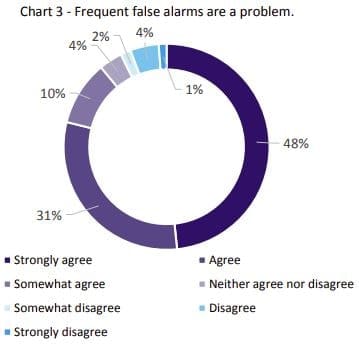
As vessels and equipment on board become
increasingly smarter, seafarers are required to learn additional
skills for the ongoing operation and maintenance of these
technologies. The installation of additional and new technology
on board should always be done with the intention of enhancing
the seafarer’s ability to safely and efficiently navigate
and operate the vessel.
However, with more equipment comes the potential for more
alarms.
In 2017/2018 the Club ran a survey in conjunction with the Department of Psychology at Royal Holloway, University of London, to investigate whether alarms on the bridge affected the attention and focus of bridge watchkeepers.
The survey was conducted by a questionnaire, which was circulated widely throughout many industry media such as the nautical institute’s publications, UK Chamber of Shipping, Intermanager, ISWAN and the Club’s media channels. After careful collation, we are now pleased to present our findings to our Members, the survey participants and the wider industry. Firstly, it is important to show the background information of the respondents. As you can see (charts 1 and 2) submissions were mainly from Masters and were from a wide variety of vessel types.

The next question asked participants about the alarms themselves: Are false alarms a problem and are alarms graded to alert the watchkeeping of more urgent situations?
As can be seen in chart 3, 89% of participants thought false alarms were a problem and in a further question (not shown graphically) 66% said the alarms were not easily detectable. The answers collated in the chart 4 illustrate that 57% of responses disagreed that alarms are graded by sound. This result was further supported by a high number of free text comments which corroborated this view.


The survey participants were then asked to comment on their knowledge of alarms and the systems they represent (chart 5). It was positive to note that 85% of participants agreed that they were aware of the alarms and the systems. However, when reviewing the free text comments, 50% of participants reported some frustration with the format of the alarms themselves. The issues disclosed mainly concerned the sounds being the same tone for all alarms and there being no distinguishing factors between alarm systems.

When asked for comments on the statement ‘Alarms that reoccur frequently are sometimes ignored/silenced and not actioned, as they are not considered a priority when carrying out other navigation/watch-keeping duties’ (chart 6), some responses confirmed the statement which may relate to the issue highlighted in the previous responses regarding the difficulty of distinguishing between alarms.
The results from this statement could be taken as indicating that 77% of crew do not want to be disturbed from their watch keeping duties. This could be interpreted as a positive result, however, this result also presents a danger that the crew will not recognize the importance of the alarms sounding and could be unaware of an emergency developing. The results from these questions present a reoccurring theme regarding the grading of alarms to assist the watch keeper.

Another factor that appeared frequently in the free text answers was the crew’s readiness to silence alarms without investigation due to ‘alarm fatigue’ caused by repeated alarm soundings for no apparent reason (chart 7). This is reflected in this chart where 45% of the respondents agreed that this happened. When this was analyzed by the level of role, 44% of Masters, 41% of Chief Officers, 48% of Second Officers and 60% of Third Officers agreed, showing that this practice was prevalent among all ranks.
A further concern is that, with respect to the Bridge Navigational Watch Alarm System, 24% (56) of participants reported that they never or seldom engaged this system (not shown graphically).

To conclude the survey evaluation (chart 8), we have reviewed and collated all the free text comments received in the survey. As chart 8 identifies, the main issue raised was frequent alarm fatigue followed by the alarms being hard to identify and then the design of the alarms system or bridge itself.

It is evident from the feedback of these seafarers that the current regulations and arrangements relating to bridge alarm monitoring and systems can be improved upon to allow crew to fully utilize the benefits of the technology being made available to them. Doing so would improve the working environment of seafarers and may assist with the reduction of related claims experienced by Members and the wider maritime industry. The Club is sharing this information to help facilitate further discussion of the topic in the industry with the hope of finding a method to provide a solution which improves bridge alarm management on board.

